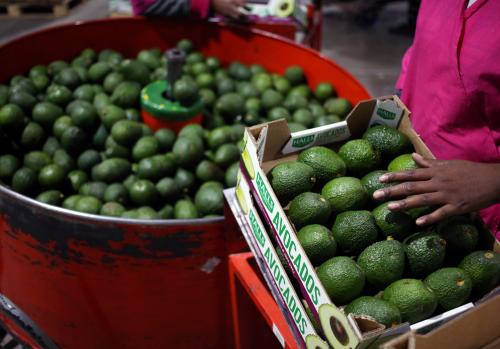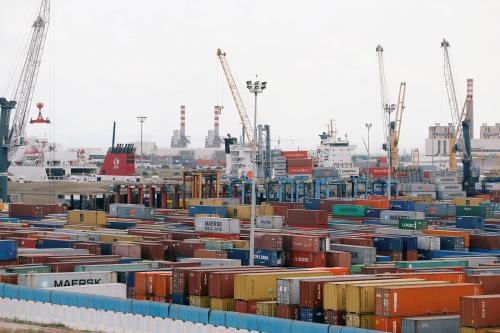From the near pinnacle of a customs union, the old East African Community (EAC) came crashing down in 1977. Why? Political differences between the erstwhile leaders and perceptions around unfair distribution of the benefits and costs of regional integration halted the momentum. Through rebirth and enlargement, though, the new EAC has again risen to great heights as one of the most successful integration schemes on the African continent. Then again, recent headlines like “Uganda, Rwanda feud restricts free movement” and “Uganda and Rwanda trade accusations over border crossing dispute” are stark reminders of some of the difficulties that precipitated the demise of that previous integration experiment.
The unfolding situation in East Africa is of global relevance as we can see many familiar dynamics at play in the context of debates on trade and integration globally. Take, for instance, in the European Union (EU), where tensions have been heightened over recent years. Is free trade and integration only beneficial to the already successful economies but harmful to the countries in the periphery? What about Brexit, which has raised a bucket-load of questions regarding national identity, political legitimacy of institutions outside of national borders, and “local” trade versus global trade? Or how about current U.S. tariff policy and the attendant debate about the concepts of “free” trade versus “fair” or “beneficial” trade?
A brief history of the East African Community
As far back as 1917, Kenya and Uganda formed an East African customs union that entailed free intra-area trade and a common external tariff. Tanganyika (now part of Tanzania) joined the union in 1927. Many of the colonial structures of the 1917 customs union soon petered out.
With independence in the 1960s, there was tremendous euphoria. The three newly independent nations enthusiastically relaunched the EAC in 1967. There was free movement of people within the community. Intra-area trade grew significantly. Common services—universities, airlines, railways, and other infrastructures—arose. Soon, though, the community’s terms of endearment began to unravel, only to collapse just 10 years later.
With its avid pursuit of market-oriented policies, an efficient port (Mombasa), functional transportation and communication infrastructure, and fledgling but promising tourism industry, Kenya clearly held competitive advantage within the community.
At odds with Kenya’s path, Tanzania chose a course of socialism in the Arusha Declaration of February 1967. Grassroots development through “ujamaa” (family sharing) was a central tenet of poverty reduction. Most notably, government control of the commanding heights of the economy was an essential element of this Tanzanian experiment up to the early 1980s. Domestic investment was severely stifled and inflows of private foreign capital came to a halt as the investment climate proved unfavorable.
Then there was a much bigger problem. No one could have predicted the emergence of President Idi Amin of Uganda and his disruptive effect on the experiment. For example, with his entry onto the political scene, meetings of the triumvirate authority (Presidents Idi Amin, Jomo Kenyatta, and Julius Nyerere), the highest decision-making organ of the EAC stopped. This dramatically new operating environment seriously undermined trust—a key ingredient for successful economic and political integration, especially among newly-independent states. The community collapsed in 1977, though a mediation agreement was reached for the division of assets and liabilities and to explore potential areas for future cooperation.
Rebirth and enlargement
The EAC was reborn on July 7, 2000, following ratification of the treaty of establishment by the three member states. By January 2005, the governance structure and institutions were in place and the customs union became operational. Burundi and Rwanda became members of the EAC in July 2007 and joined the customs union two years later.
Further enlargement occurred in September 2016 when South Sudan joined the EAC. Below is a timeline of salient events.
At about 195 million, the population of the six EAC member states exceeds the entire population of the nine countries of Western Europe, including Germany, France, the Netherlands, Belgium, Austria, Switzerland, Luxemburg, Monaco, and Liechtenstein.
According to the African Development Bank’s 2019 African Economic Outlook, East Africa is the fastest growing region of the continent with a robust GDP forecast of 5.9 percent from an estimated 5.7 percent in 2018.
Kenya is to the EAC what Germany is to the EU—the export powerhouse, and over recent years exports and imports have indeed risen significantly between East Africa and the rest of sub-Saharan Africa. In particular, Kenya has maintained a trade surplus vis-à-vis sub-Saharan Africa and a significantly higher one with the EAC, amounting to, on average, about 1 percent of Kenya’s GDP between 2016-2017.
Is history about to repeat itself?
This question seems an obvious one based on recent headlines like “Rwanda, Uganda trade barbs as dispute grows” just last month. Cross-border tensions such as this are causing some commentators to ask whether East Africa’s prior history of disintegration is resurfacing. Accusations and counter accusations of a “trade war” have emanated from both Kampala and Kigali while relations between the two heads of states have significantly cooled. Meanwhile, the Katuna/Gatuna border post between Rwanda and Uganda—one of the busiest crossing points between the two countries—remains closed. This escalation has further raised the specter of a breakup of the EAC.
The Rwanda-Uganda border closure is taking its toll. Trucks are re-routed to alternative border posts, incurring higher travel times and other charges. It is also disrupting regional trade between the two countries, with the Democratic Republic of the Congo, and to the internationally facing seaports in Mombasa and Dar-es-Salaam. Were the EAC to collapse, the consequences would not be confined to the East Africa region. At a time of decelerating growth in China, Brexit, turbulence in Europe and the United States, and a predictably cautious outlook for the economies of sub-Saharan Africa, the last thing the continent needs right now is an “own-goal” in East Africa that stutters economic growth, destroys jobs, and exacerbates poverty.
Why is this time different?
The continental momentum toward an integrated Africa. As chairman of the African Union in 2018, Rwandan President Paul Kagame initiated a series of reforms to transform and unify the institution and its member states. A unified air transport market across the continent was also created. His leadership was instrumental in launching the framework agreement for the African Continental Free Trade Agreement (AfCFTA) signed by 44 African heads of state and government in Kigali on March 21, 2018. Effectiveness of the trade pact is now assured with the successful ratification by the required 22 member states.
Kagame has continued his push for regional integration since he became chairman of the EAC in 2019, and a great milestone would be to fix the dispute with Uganda and reopen the border. He believes that the closer the affinity attained by members of regional blocs, the easier it will be to foster Africa’s integration. One would therefore hope that Kagame’s demonstrated continental leadership will translate to the expeditious resolution of the current border crisis between Rwanda and Uganda.
Geography. Four of the member states of the current EAC—Burundi, Rwanda, South Sudan, and Uganda—are landlocked and intra-area trade is still far below potential. The key to a prosperous future lies in the development and linkages of infrastructure—roads, railways, airports, seaports, and information and communication technology. For example, the member states are rejuvenating existing railways that serve Tanzania, Kenya, and Uganda. These will be extended to Rwanda and Burundi and ultimately to South Sudan, Ethiopia, and beyond. Construction works on the Kenyan section have already begun. Such infrastructure would not only facilitate the exchange of ideas and the speedy movement of people, goods and services, but also cement diplomatic and other relationships, boost intra-area trade, and contribute to continental and global integration.
Institution building. In 2017 and 2018, the EAC made considerable progress in building and strengthening its institutions. For example, more “one stop” border posts—designed to further link EAC members more deeply to expedite customs clearance—have been constructed Arrangements to roll out products under the single customs territory as well as upgrades to electronic cargo tracking systems have also been established.
Economic reforms. EAC countries have continued to push the frontiers of reforms more broadly. The World Bank’s 2018 Doing Business report showed the progress made by sub-Saharan Africa among reforming economies. The 2019 report showed that the EAC has continued to excel, accounting for one-third of all business regulatory reforms. In fact, Rwanda and Kenya led the pack of reformers. Despite these advancements, though, several EAC countries continue to lag behind.
Concerted diplomatic efforts. To resolve the impasse between Rwanda and Uganda, Kenya’s President Uhuru Kenyatta recently embarked on a diplomatic mission to both capitals earlier in March. His concluding remarks, “the more we meet, the more we interact, the better we integrate as a people,” appropriately sum up the need for sustaining an integrated EAC. Efforts are also being made by the secretary-general of the community and the East Africa Business Council to resolve the border dispute, consistent with member states’ commitments under the Common Market and Customs Union and the EAC Treaty.
Despite the current headwinds, the prospect for an integrated EAC remains bright. That said, the member states need to pay heed to a key lesson from worldwide integration schemes. That is, that things get tough during the process. If in doubt, just look at the unfolding consequences of Brexit for the European Union. With luck, history won’t repeat itself in East Africa. At least, not at this very moment.
Note: This blog reflects the views of the author only and does not reflect the views of the Africa Growth Initiative.
The Brookings Institution is committed to quality, independence, and impact.
We are supported by a diverse array of funders. In line with our values and policies, each Brookings publication represents the sole views of its author(s).








Commentary
Headwinds toward East African regional integration: Will this time be different?
April 22, 2019